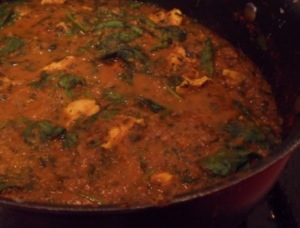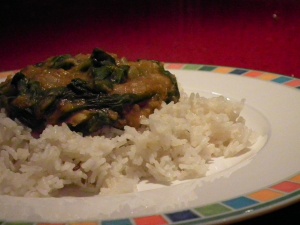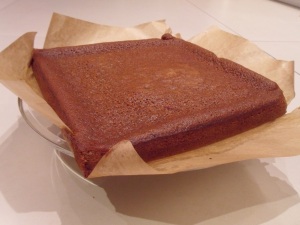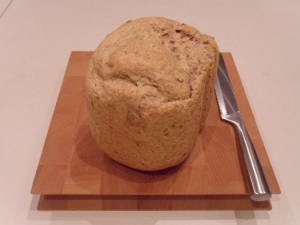A few years ago, I considered getting a vegetable box. What can I say? I was just married, living in what the estate agent called Hampstead (it was really Swiss Cottage), working with a whole bunch of well-groomed City types and spending my Sunday mornings in my local coffee shop reading the Sunday Times. A vegetable box would have completed the picture. I looked on the websites of Abel and Cole and Riverford Organic, glossing over the problem of having a weekly delivery to our third floor flat when we were both at work every day, and excitedly told Jon all about it.
He wrinkled his nose. “So each week we get a box of random vegetables, which someone else has picked out, some of which we don’t like, and then we pay more for the privilege of knowing that they are grown on some farm not very near us?” It did sound a bit barmy, then, so we went off to Waitrose (of course) and, crazily enough, picked out a selection of vegetables that we both liked and wanted to use.
I mentioned that episode to a friend and he told me that I had missed the point of vegetable boxes. Apparently the whole fun of it is that you get interesting vegetables (for which read beetroot, or turnip) that you wouldn’t otherwise buy, and then the challenge is to make something out of it that you wouldn’t have otherwise made. It all sounds a bit Blue Peter and not really the way I like to shop or eat. Generally in this house we pride ourselves on not having very much wastage. We bake our bread and then when it is stale, turn it into breadcrumbs. We freeze leftover portions or take them to work for lunch. We use up vegetables in soups and fruit in pies and sorbets. But sometimes we’ll buy something because I have a specific recipe in mind, and then I don’t need very much of it and we have loads of it lying around. I confess that I would probably forget about it and let it languish in the bottom drawer of the fridge for a few weeks, but if there is a loose end in the fridge Jon is on it. “Half a bag of spinach? What are we doing with that?” “There are two leeks and half a swede, what’s happening with them?” It’s like having my very own awkward vegetable from the vegetable box, but I generally choose the vegetable and it’s not a horrible turnip. But the challenge is still on.
That is what happened this week with mushrooms. We had a load of different ones – shiitake, portabellini, chestnut – some of which I’d used to make a mushroom ragu to have on polenta squares as a starter for lunch on Saturday (to be blogged another time). I had a hunt around for a nice recipe to use them up and found a Spanish mushroom and lentil recipe which looked nice, but then I had lentils for lunch and didn’t want them. With Yom Kippur tomorrow, if we didn’t eat them tonight we’d have them hanging over our heads until Thursday and I knew we had to get them out of here before then. I had things to cook for Yom Kippur tonight and couldn’t be bothered with anything complex, and really just wanted something delicious and simple and comforting.
Step forward, Jamie Oliver, with your simple, light and quick pappardelle with mushrooms. I’ve laughed at Jamie on this blog before for his nonsense malteser ice cream recipe, but I know that really, like this pasta, he is a good, simple, hearty fellow, and he means well. This is a super quick, easy weeknight dinner. A bit of a carb-fest, and not massively high in protein (eeeek) but using egg pasta helps, and if you use shiitake mushrooms you get a bonus portion of vitamin D, and the parsley gives you some equally elusive vitamin K. It’s surprisingly filling, too.
Serves 2
- About 400g mixed wild mushrooms
- 2 tablespoons olive oil
- 1 dried red chilli, finely chopped
- 1 garlic clove, crushed
- Juice of half a lemon
- Small bunch of flat leaf parsley, finely chopped.
- Fresh egg pappardelle for 2 (about 250g)
- Salt and pepper
- Clean the mushrooms and slice them thinly
- Put the olive oil in a very hot frying pan and then add the mushrooms, frying quickly. Add the garlic and chilli and some salt and pepper.
- Continue frying for 4 or 5 minutes and then turn the heat off, and add the lemon juice and half the chopped parsley. Check the seasoning.
- Meanwhile, bring a saucepan of salted water to the boil and cook the pasta.
- When it is cooked, pour a little of the pasta water into the frying pan with the mushrooms, drain the pasta and add to the frying pan, tossing to coat with the liquid and mixing the mushrooms in.
- Serve, garnishing with the rest of the parsley.
For the baby-friendly version, as above but without the salt (and maybe without the chilli, depending on how your baby deals with chilli). You will have to cook the pasta separately, because the salt in the water is essential for the adult version.
*Approximate nutritional values*
- Calories: 520 kcal
- Carbs: 72g
- Fat: 19g
- Protein: 19g
- Sugar: 2g
- Sodium: 1766mg






